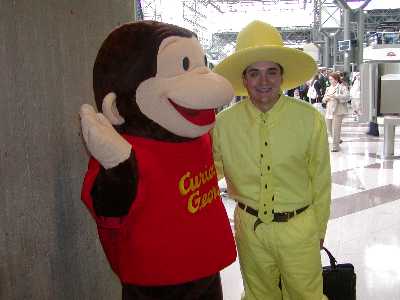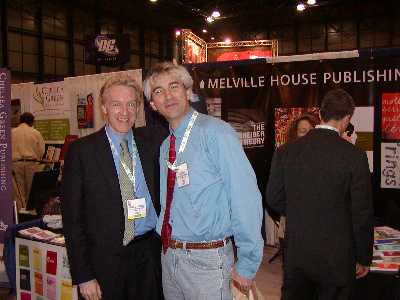
Author / DrMabuse
BEA: Young and Hybrid Editors Panel & The State of the Publishing Industry
The publishing industry is a strange business. For one thing, the product that a publisher sells isn’t necessarily guaranteed a profit. While this could be said of other products bought, sold or bartered for, there is a unique difference in the book world. You see, the profit margin is contingent not on the amount it takes to produce the labor, but on the difference between advance and royalties paid out to author (ideally as low as possible, which is interesting given that it is the author who creates, pitches and slaves over the work in the first place), the printing costs and amount shilled out to staff (also ideally as low as possible) and the net sales that come from a book’s sales through a distribution method that is equally batty (printing a book from a press, shipping all these copies out to warehouses, and then further shipping all of these to various booksellers) and time-consuming (the production process alone takes up to a year and a book might tank after three weeks).
It is strange in the sense that certain formats carry stigmas by buyers and sellers alike. If a book is self-published, it is genuinely considered crud (in most cases, with good reason). If a book bypasses the delectable hardcover stage and is issued anew in paperback, it is either genre or of questionable literary merit. (And often the two go hand in hand, no matter how seasoned the efforts.)
The publishing industry has responded to setbacks in sales by publishing even more books (150,000 last year), which is about as sensible as slaughtering five hogs to make three ham sandwiches. Further, even the sharpest minds in the industry (the publicists with the ideas, the editors who hone a book to fit a market, the MFAs shrewd enough to discern a dunce from a diamond) have no definitive idea about the “future of publishing,” a nebulous catch-all term that could mean everything and nothing. It is this “future of publishing” that catches voices in sussration, that has the eyes roll back into dollar signs shanghaied from a 1940s cartoon, that forms the basis of panels and deals.
Yet nobody can make a clear call.
The good news is that, like roulette, any number can win and any player on the table could make a killing. Never mind the odds or the right hand not knowing what the left hand is doing or that the guiding brain behind these two hands (read: executive managers) is often slow to change, innovation, or experiments. Understandably so, because if it takes two years to clear things with the editors, the money men, and the people who distribute the books for purchase and consumption, then one must abide by a clear outline. Lack of planning is, after all, what made the initial attempt to build the Panama Canal such a disaster.
But the nice thing is that anything and everything can be published, provided it is profitable. Skirmishes and disagreements can be set aside because the one thing that everybody can agree upon is money. Dennis Loy Johnson told me that when he met with booksellers, they knew him as the Moby Lives rabble-rouser. But this didn’t prevent him from selling the goods or meeting chain resistance in the brick and mortar stores. And in the Generation Next panel I attended, one editor pointed out that self-publishing shouldn’t be necessarily dismissed, pointing out that a book in the streets managed to sell 200,000 coppies.
Because this is a business, it also means that the literary author who unexpectedly found success with a flagship title can be wooed by a bigger publisher hoping for the steady turnaround, leaving the small guy flinging whatever silent code of commitment into the dust. It also means that the reverse situation is true, where an author who doesn’t sell can also find himself standing in the dole line (not that he isn’t already).
The above is more or less what I’ve put together from the people I’ve talked to at BEA and my own perceptions (pre-show and post-show). A lot of this was discussed in the aforementioned Generation Next panel (which I plan to summarize in a future post). But I’ve come away with a greater appreciation for what publishers do and with the unique dilemma and strange system that they face.
I attended the Generation Text panel on Friday. The panel, a collection of “hybrid young editors,” included:
- Liz Nagle, Associate Editor, Little Brown & Co.
- Chris Jackson, Editor, Crown Publishers
- Lorin Stein, Editor, Farrar, Strauss & Groux
- Gillian Blake, Executive Editor, Bloomsbury
- Kate Travers, Editor, HarperCollins
The panel was moderated by Steve Zeitchik, News Editor of Publishers Weekly.
SUMMARY:
The room was again SRO. I strongarmed my way to the front to take notes in what little floor space remained at the front of the panel table.
Steve Zeitchik asked if publishing was heading towards a “winner take all approach” and a reading climate where everybody was reading the same book. He wondered if the editors had any specific strategies to promote reading or specific titles.
Gillian Blake responded by saying that any campaign of this sort could start with TV, but expressed concerns that there wasn’t enough space in people’s consciousness for books.
Chris Jackson noted that grassroots politics were instrumental in marketing The Lies of George W. Bush. The book did well because of its ability to tap into Working Assets and similar conduits. He said he wasn’t completely pessimistic.
Lorin Stein, who struck me as a dour and humorless numbers man (which I suppose you have to be in this business, even if you are an editor), said that publishers needed to spend more time making phone calls and sending letters. He noted that publishers were resonsible for more books per editor.
Liz Nagle said that she had lots of success with Yiddish with Dick and Jane at Little Brown courtesy of Vidlit (which was discussed here yesterday). The Vidlit Flash shorts were emailed from person-to-person. But even this innnovative success is not what Little Brown is spending all of its days doing this.
If I had to peg the smartest and most open-minded person on the panel, I’d say that it was Kate Travers. Unlike the other panelists, Travers immediately cut to the chasm between the publishing community and the public community. She compared the hardcover with the oldest child (the glamour child), the forefront symbol of literature and the paperback as the cute little child. The original trade paperback, meaning books that are published directly to trade paperback without benefit of a hardcover release (books along the lines of The Interpeter of Maladies and Bright Lights, Big City), was something of an awkward middle child, but she adamantly supported it, pointing out that it had not received enough recognition as a viable format.
Travers bemoaned the fact that publishers don’t want to gamble on new authors. Her mission as an editor is to fulfill the life of a book and destroy the perception that an original TPB is “not good enough for hardcover.” But she said this situation is changing.
Blake weighed in with the hard economics. If a publisher commits to an original TPB, then they need to be confident that it will be $60,000. Because you’re only talking about $1 per book. An original TPB needs to hit the bestseller list to make its money back.
Sam Lipsyte’s Home Land was brought up. When asked about how much Lipsyte was paid for the book, Stein responded, “It was criminal how low we paid out.”
Zeitchik, perhaps making up for the previous day’s inadequate discussion on the subject, brought up the 18-34 question and what responsibilities editors had to this crowd.
Travers, again demonstrating some pragmatism on this subject, pointed out that literature was in a serious crisis vis-a-vis younger readers. She pointed out that people in their late twenties still reach for a video game and, as Gillian Blake also pointed out, don’t necessarily spend their Sunday afternoons reading a book for a few hours. If they do buy a book, they’d rather wait the extra year for the trade paperback than shell out the twenty-five bucks. She hoped that there could be an alliance built to back up editors and pointed out the authors being stolen away from the small presses.
Jackson remarked that the pie has to get bigger, so that books will draw young adults. One of his titles, Angry Black White Boy, was a success because of its marketing. Crown had distributed stickers, mix CDs and even put up a graffiti wall. These were concrete efforts to pitch to young audiences in what he called an “authentic” way . He also noted that because of Def Poetry Jam, young teenagers stood around the block to get into a poetry reading. He insisted that “the audience is there.”
Zeitchik brought up the previous day’s resistance on the 18-34 panel, noting that many people in the audience expressed resistance that this audience was not thinking commercially (or even practically) about this pivotal audience.
Travers pined for a more collective atmosphere and hoped that open forums such as book fairs (one of which she was organizing in Brooklyn) could get people talking about literature again.
Stein had the novel idea of reintroducing corporate mandates for literary publishing, pointing out that this used to be a practice among the big houses.
Blake confessed that today’s books might very well be a matter of publishing work that these editors are proud of when they’re old and tired. Literary publishing is equally unforgiving with young and hip editors.
Jackson said that today’s publishers and editors needed to be more connected with the bookstore atmosphere. He said he had learned a lot because his wife had opened up a bookstore and that this had transformed his understanding. At Random House, staffers went to various Wal-Marts to observe how people bought books and how they selected them, gauging their excitement and lack of excitement w/r/t their choices.
Nagle was willing to go further by having Little Brown employees work in a bookstore for a week.
Blake suggested that publishers were “punished for their success.” The problem with finding the next Kite Runner is that the shareholders will demand more money the following year and that they would then be paying outrageous sums to the same author for a repeat success. She insisted that, in most cases, the first book would sell the most, implying very strongly that this author payouts were a signinficant problem.
Stein’s hard statement: “Give me a book that sells 300,000 copies. I don’t care how crummy it is, I’ll publish it.”
Jackson said that the problem isn’t so much demand, but the bidding wars that come with a hot title.
Blake singled out another problem: retail returns. If a book is likely to be marked down, where’s the incentive to order extra copies if the customer or the retailer knows that they’re going ot pay less later.
Small presses do play into the consciousness. Stein remarked that since it is easier to publish a book these days with advancing technologies, a small publisher is almost on the same footing as one of the big boys. There has been diversity despite the growing conglomeration.
Traver suggested that self-publishing shouldn’t be ignored. She singled out The Rules of the Game, a book that she had seen people reading on the subways. She was unable to find the book, but learned that people had bought this on the street. After Bookscanning the title, she learned that it had sold 200,000 copies.
CONCLUSIONS:
Zeitchik was a very good moderator, constantly keeping the conversation flowing with seminal questions. But the panel, which hoped to tackle many important questions, only created more.
The gist I seemed to get here is that today’s publishers, even the more literary-minded ones, are almost completely out of step with today’s audiences. Random House’s trip to Wal-Mart is a start, but I’m mystified why they didn’t go to a bookstore — seeing as how most people of a book-minded persuasion are going to go to a place that specializes in books. Call me practical, but this might be the behavior that is worth observing.
Further, since there are few guarantees that a publisher might be profitable, Stein’s hard idea about literary mandates is a good one. As much as these editors bemoaned the “everyone is reading the same book” school of thought, their companies are dictated by finding the next Dan Brown . And it was interesting to see their editorial attitudes reflecting this.
The other lingering question: are publishers responsible to some degree for the dropoff in reading with the 18-34 crowd? If they are not fully accessing them, then should they be allocating more resources to this? Or is this too much of a long-term financial thing even for Random House?
Television and community awareness seems to have played a seminal part in promoting reading. But so has the Internet with the Vidlit idea. If the publishing industry moves at the rate of a dinosaur and the act of consuming media only accelerates, is it little wonder then why readership has dropped?
I still have a remarkable amount of data here to process, but I’m running late on little sleep and much coffee and I again have too many things that I’m doing today. Factor in the ridiculous amount of books I have to ship back to San Francisco and you see my dilemma. I hope to get more pictures up today and brief reportage and another massive post up tomorrow. I’m sitting on two minidiscs of interviews, which includes the publisher of the 2005 Man Booker International winner. More to come.
I will say that I agree with Mark. I’ve had enough of these panels. They are essentially repetitions on the same two themes: the “future of publishing” and whatever misunderstood technology happens to be percolating at the moment. I’m also inclined to observe that this industry seems to be a matter of endlesly putting things into action and I suppose has enough returns to keep it self-supporting. But while this has allowed it to preservere through the 20th century, the 21st century, with its Amazons and its Oprahs, includes far more variables for a venture than meets the eye. This may in fact be good for the small publisher who is attuned to the book-buying public and might explain why niche publishers are doing so well.
But for the big boys, and even the mid-sized folks, the answer to me seems startlingly clear: become aware of the shifting paradigms (which, yes, includes book blogs) and dare to put your money where your mouth is. Or to put it succinctly:
Adapt or perish.
The Monkey’s Big Enough to Eat the Man in the Yellow Hat

[ABOVE: Curious Georges insisted on shaking my hand. Since he frightened me and I was thinking about Howard Hughes, I figured that taking his photo would be the only sure way to scare him away.]
Who is Jacob Javits?

[ABOVE: A statue of Jacob Javits, a senator apparently of some purport and the person whom this convention center is named after. Could someone give this Californian a history lesson? I’m genuinely curious if a chair was involved during Senator Javits’ career.\
Visual Proof That Moby Lives

[ABOVE: Dennis Loy Johnson and David Kipen, in front of the Melville House booth.]
I spoke to Dennis Loy Johnson, Valerie Merians and David Kipen. It seemed that Melville House was the convergance point. More to come about what we talked about, except that Kipen has a very ambitious idea in an upcoming book (and I, as a gentile, have a horrible memory for words that begin with “sch” — fortunately the good and remarkably energetic Kipen didn’t hold this against me) that boldly challenges the auteur theory.
Believe it or not, I also shook hands with Jessa Crispin, who I ran into by chance at the Melville House booth. She left before I could talk with her further (my fault, because I ended up speaking with Kipen for quite a while). But let it be publicly stated that, as a gentleman who thinks petty rivalries are silly and largely ignores these things, I openly offer my hand towards a detente against all perceived offenses on all sides. The question here is whether or not Ms. Crispin is equally willing.
On the floor, there are numerous publishers of many stripes. Everything you can imagine has found a way to be published. I’m not sure where I stand on the grand irony of a Caucasian publisher profiting in “history” written by Black Muslims (i.e., the Farrakhan crowd). But that’s the kind of fringe stuff you find in the back.